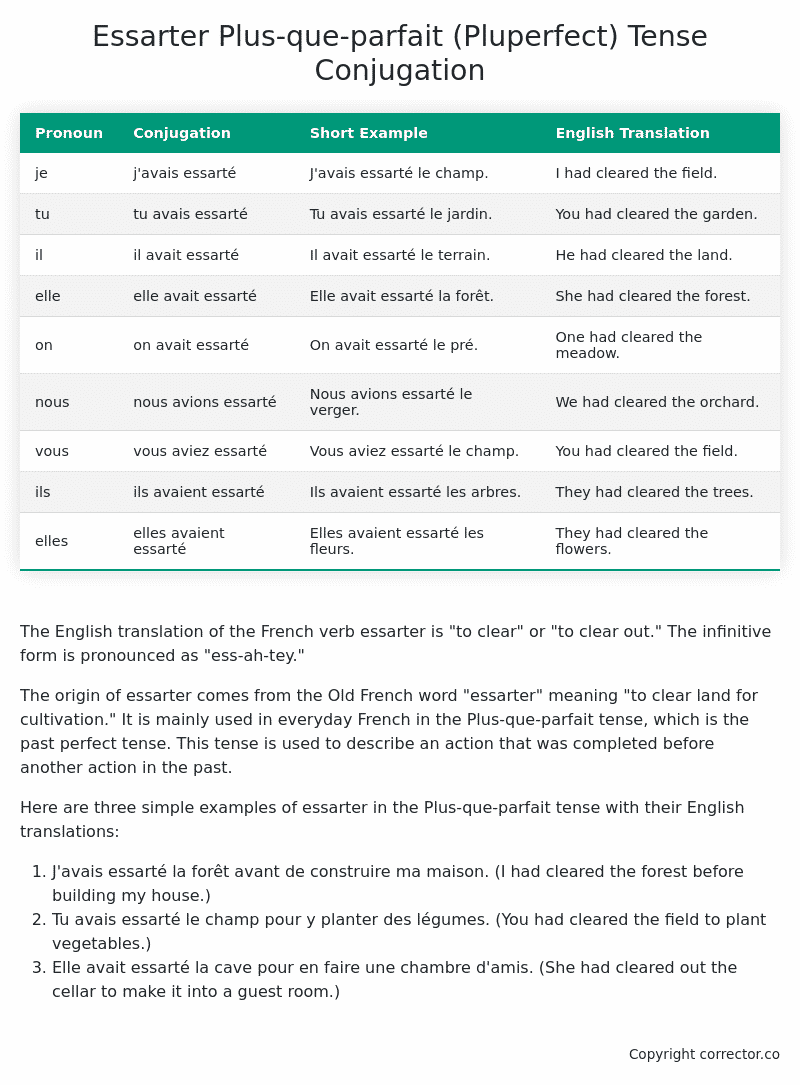Plus-que-parfait (Pluperfect) Tense Conjugation of the French Verb essarter
Introduction to the verb essarter
The English translation of the French verb essarter is “to clear” or “to clear out.” The infinitive form is pronounced as “ess-ah-tey.”
The origin of essarter comes from the Old French word “essarter” meaning “to clear land for cultivation.” It is mainly used in everyday French in the Plus-que-parfait tense, which is the past perfect tense. This tense is used to describe an action that was completed before another action in the past.
Here are three simple examples of essarter in the Plus-que-parfait tense with their English translations:
- J’avais essarté la forêt avant de construire ma maison. (I had cleared the forest before building my house.)
- Tu avais essarté le champ pour y planter des légumes. (You had cleared the field to plant vegetables.)
- Elle avait essarté la cave pour en faire une chambre d’amis. (She had cleared out the cellar to make it into a guest room.)
Table of the Plus-que-parfait (Pluperfect) Tense Conjugation of essarter
| Pronoun | Conjugation | Short Example | English Translation |
|---|---|---|---|
| je | j’avais essarté | J’avais essarté le champ. | I had cleared the field. |
| tu | tu avais essarté | Tu avais essarté le jardin. | You had cleared the garden. |
| il | il avait essarté | Il avait essarté le terrain. | He had cleared the land. |
| elle | elle avait essarté | Elle avait essarté la forêt. | She had cleared the forest. |
| on | on avait essarté | On avait essarté le pré. | One had cleared the meadow. |
| nous | nous avions essarté | Nous avions essarté le verger. | We had cleared the orchard. |
| vous | vous aviez essarté | Vous aviez essarté le champ. | You had cleared the field. |
| ils | ils avaient essarté | Ils avaient essarté les arbres. | They had cleared the trees. |
| elles | elles avaient essarté | Elles avaient essarté les fleurs. | They had cleared the flowers. |
Other Conjugations for Essarter.
Le Present (Present Tense) Conjugation of the French Verb essarter
Imparfait (Imperfect) Tense Conjugation of the French Verb essarter
Passé Simple (Simple Past) Tense Conjugation of the French Verb essarter
Passé Composé (Present Perfect) Tense Conjugation of the French Verb essarter
Futur Simple (Simple Future) Tense Conjugation of the French Verb essarter
Futur Proche (Near Future) Tense Conjugation of the French Verb essarter
Plus-que-parfait (Pluperfect) Tense Conjugation of the French Verb essarter (this article)
Passé Antérieur (Past Anterior) Tense Conjugation of the French Verb essarter
Futur Antérieur (Future Anterior) Tense Conjugation of the French Verb essarter
Subjonctif Présent (Subjunctive Present) Tense Conjugation of the French Verb essarter
Subjonctif Passé (Subjunctive Past) Tense Conjugation of the French Verb essarter
Subjonctif Imparfait (Subjunctive Imperfect) Tense Conjugation of the French Verb essarter
Subjonctif Plus-que-parfait (Subjunctive Pluperfect) Tense Conjugation of the French Verb essarter
Conditionnel Présent (Conditional Present) Tense Conjugation of the French Verb essarter
Conditionnel Passé (Conditional Past) Tense Conjugation of the French Verb essarter
L’impératif Présent (Imperative Present) Tense Conjugation of the French Verb essarter
L’infinitif Présent (Infinitive Present) Tense Conjugation of the French Verb essarter
Struggling with French verbs or the language in general? Why not use our free French Grammar Checker – no registration required!
Get a FREE Download Study Sheet of this Conjugation 🔥
Simply right click the image below, click “save image” and get your free reference for the essarter Plus-que-parfait tense conjugation!

Essarter – About the French Plus-que-parfait (Pluperfect) Tense
Tense Formation
Common everyday usage patterns
Sequencing of past events
Background information
Hypothetical or reported speech
Interactions with other tenses
Summary
I hope you enjoyed this article on the verb essarter. Still in a learning mood? Check out another TOTALLY random French verb conjugation!


